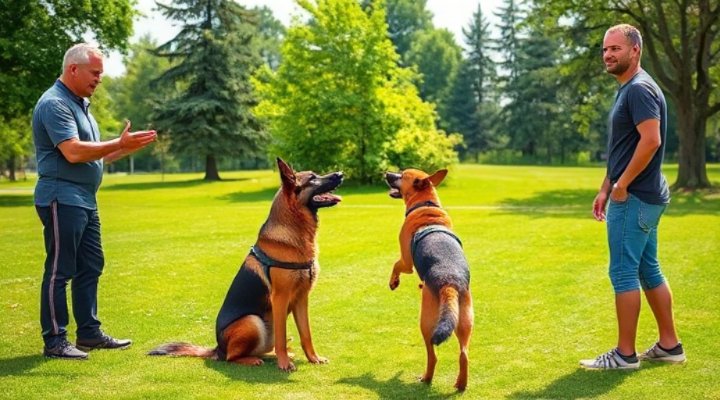Summary: Professional dog obedience training is the foundation for creating a harmonious relationship between you and your canine companion. This comprehensive guide covers everything from basic commands to advanced techniques, ensuring your dog becomes the perfect well-behaved pet you’ve always wanted. We’ll explore effective methods that work for all breeds and ages, making the training process enjoyable for both you and your furry friend.

Understanding the Fundamentals of Dog Obedience Training
Dog obedience training begins with understanding canine psychology and learning patterns. Firstly, dogs are pack animals by nature, which means they respond well to clear leadership and consistent rules. Consequently, establishing yourself as the pack leader is crucial for successful training outcomes. Moreover, dogs thrive on positive reinforcement, making reward-based training the most effective approach according to numerous studies, including those from the American Veterinary Medical Association.
Furthermore, timing is everything in dog obedience training. That is to say, rewards must be given immediately after the desired behavior to create strong associations. For instance, when teaching the ‘sit’ command, the treat should be delivered the moment your dog’s bottom touches the ground. Similarly, corrections should be timely but gentle, always focusing on redirecting rather than punishing. This approach ensures your dog understands what you expect without becoming fearful or anxious.
Essential Equipment for Effective Training
Having the right tools can make your dog obedience training sessions much more productive. Most importantly, you’ll need high-value treats that your dog absolutely loves. Additionally, a properly fitted collar or harness and a 6-foot leash are essential for control during training sessions. Meanwhile, clickers can be incredibly useful for marking desired behaviors with precision. However, remember that the most important tool is your consistency and patience throughout the process.
Interestingly, many owners find that incorporating training into healthy feeding routines creates additional bonding opportunities. For example, using portion of your dog’s regular meals as training rewards can be both effective and nutritionally balanced. This approach also helps prevent overfeeding during intensive training periods.

Basic Commands Every Dog Should Master
The foundation of dog obedience training rests on mastering several essential commands. Above all, the ‘sit’ command is typically the first one taught because it’s relatively easy for dogs to learn and provides a solid foundation for other commands. Subsequently, ‘stay’ and ‘come’ are crucial for safety and control in various situations. Likewise, ‘down’ and ‘heel’ complete the basic obedience repertoire that every well-trained dog should know.
When teaching these commands, it’s important to break them down into small, manageable steps. For example, when teaching ‘stay,’ begin with very short durations and minimal distance. Gradually increase both factors as your dog becomes more confident and reliable. Most importantly, always end training sessions on a positive note, even if you need to ask for an easier command that your dog can successfully perform. This approach builds confidence and maintains enthusiasm for learning.
Troubleshooting Common Training Challenges
Many owners encounter challenges during dog obedience training, but most can be overcome with patience and the right approach. Sometimes, dogs may seem stubborn or distracted, but this often indicates that the training environment is too stimulating or the sessions are too long. Therefore, starting in a quiet, familiar space and keeping sessions short (5-10 minutes) can significantly improve results.
If your dog struggles with specific commands, consider whether there might be underlying issues. For instance, some behavioral challenges might relate to dietary sensitivities or health concerns. In such cases, consulting with a veterinarian can provide valuable insights. Additionally, some dogs benefit from working with professional trainers, especially when dealing with more complex behavioral issues.
Advanced Dog Obedience Training Techniques
Once your dog has mastered basic commands, you can progress to more advanced dog obedience training. These techniques not only impress friends and family but also provide mental stimulation that dogs desperately need. Firstly, duration and distance exercises enhance the reliability of basic commands. For example, practicing ‘stay’ for increasingly longer periods or from greater distances builds incredible impulse control and focus.
Secondly, adding distractions is a crucial step in proofing your dog’s obedience. This means practicing commands in different environments with various distractions present. Start with mild distractions and gradually work up to more challenging scenarios. Importantly, always set your dog up for success by managing the difficulty level appropriately. If your dog fails repeatedly, go back to an easier level and build back up more gradually.

Specialized Training for Specific Needs
Some dogs require specialized obedience training based on their individual needs or intended roles. For instance, therapy dogs need exceptional obedience skills combined with calm temperaments in various environments. Similarly, service dogs undergo extensive training to perform specific tasks for their handlers. Even family pets can benefit from learning fun tricks and advanced behaviors that strengthen the human-animal bond.
According to resources from the American Kennel Club, many dogs enjoy participating in organized sports and activities that build on obedience foundation. These activities provide excellent opportunities for continued learning and socialization. Furthermore, they offer wonderful ways to keep both you and your dog physically active and mentally engaged.
Maintaining and Enhancing Training Results
The work doesn’t end when your dog learns the commands—maintaining obedience requires ongoing practice and reinforcement. Essentially, dog obedience training is a lifelong process that evolves as your dog ages and circumstances change. Regular short practice sessions, even just a few minutes daily, help keep skills sharp. Additionally, incorporating commands into daily routines ensures they remain practical and useful.
It’s also important to continue challenging your dog with new learning opportunities. Canine brains need stimulation just like human brains, and continued learning prevents boredom and associated behavioral issues. Many owners find that exploring different training methods or activities keeps both them and their dogs engaged and excited about training. Remember that a well-trained dog is not only a joy to live with but also safer and happier in various situations.
For dogs with specific behavioral issues, sometimes professional behaviorist consultation can provide tailored strategies for particular challenges. These experts can offer insights into why certain behaviors occur and how to address them effectively within your obedience training framework.

The Joy of a Well-Trained Canine Companion
The ultimate reward of dedicated dog obedience training is the deep, trusting relationship you build with your canine companion. A well-trained dog can accompany you virtually anywhere, enriching your life with shared experiences and adventures. Moreover, the communication skills developed through training create a bond that transcends basic pet ownership, evolving into a true partnership based on mutual understanding and respect.
In conclusion, dog obedience training is one of the most valuable investments you can make in your relationship with your pet. The time and effort you dedicate to training will回报 with years of enjoyable companionship and the peace of mind that comes with having a well-behaved canine family member. Whether you’re starting with a new puppy or working with an older dog, it’s never too late to begin this rewarding journey toward perfect pet companionship.
Related Keywords: dog training techniques, canine obedience, pet behavior modification, command training, positive reinforcement training, dog training tips, obedience classes, puppy training, advanced dog training, behavioral training solutions

